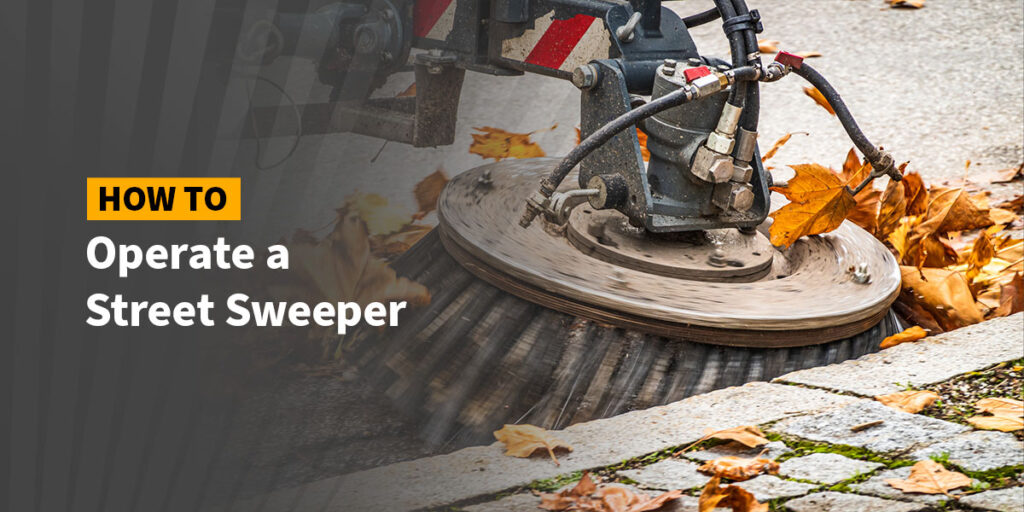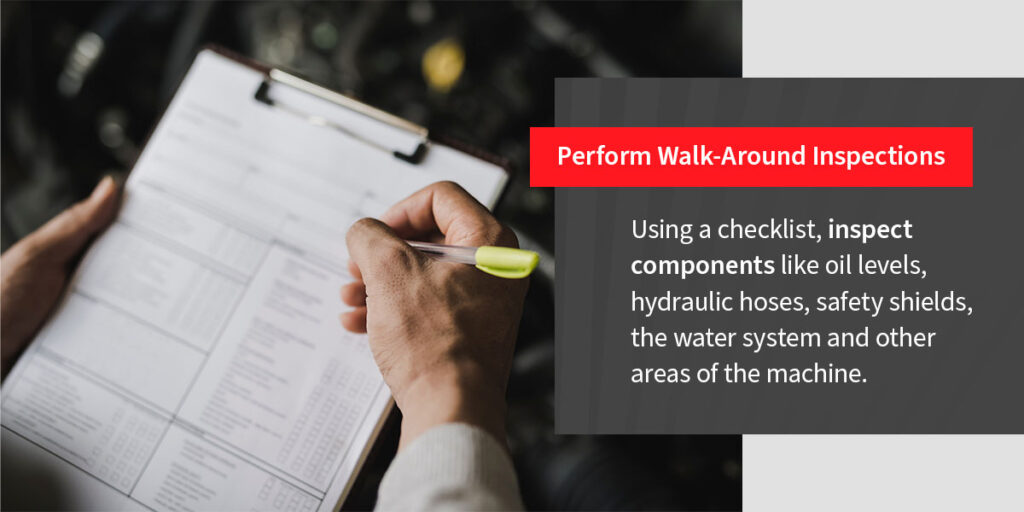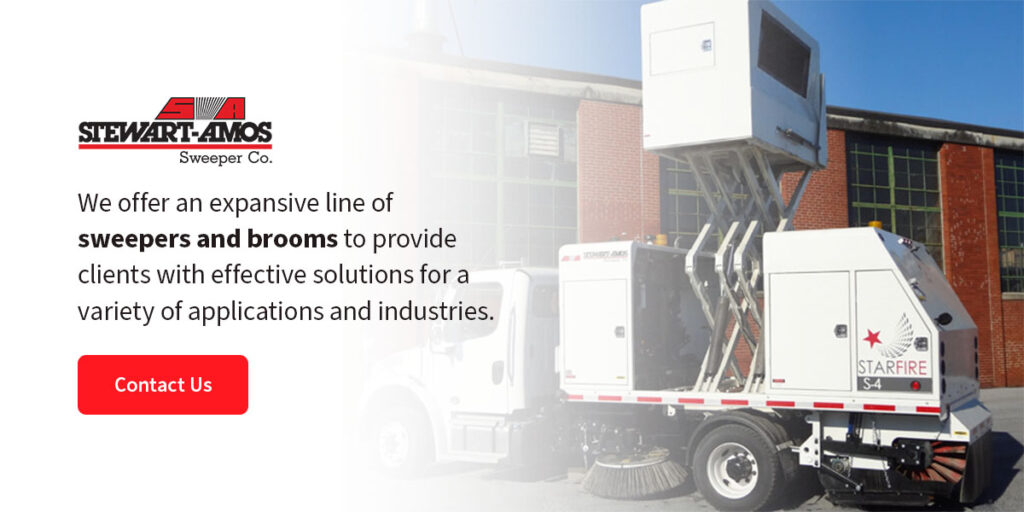
The act of street cleaning dates back to the early 1900s. Today, street sweeping is important to keeping roads and parking lots free of visible debris and pollutants that would otherwise end up being washed into nearby water sources. Despite a road looking clean, toxins, heavy metals and nutrients attached to small particles on streets can pollute the environment around the road.
To properly and safely clean streets and parking lots with a street sweeper, the operator must be thoroughly trained in how to operate a sweeper.
Basics of Operating a Street Sweeper
There are two main street sweeper operations — sweeping and dumping. While it is best to consult the manual for manufacturer-specific operating instructions, here are the basics of sweeping and dumping operations:
Sweeping Operations
After ensuring anyone in the surrounding area is at least 10 feet away from the sweeper, you can turn it on. Make sure the hopper is in the down position and idle the engine. To warm up the engine, run it up to the RPM range for normal street cleaning. This may vary depending on the sweeper — for Stewart-Amos sweepers, it should be in the 2300-2400 RPM range. When the debris gets heavy while sweeping, you should increase the RPM to the maximum.
Next, lower the brooms and turn on forward turning so they are in sweeping position. This makes the main broom and gutter brooms start turning. If dust suppression is needed for the job, turn on the water pump, which will activate pressure spray to the gutter broom, front and rear spray bars. With everything up and running, you can start the job.
If the brooms get blocked up with debris, switch their controls to reverse until they are clear, then resume sweeping. Additionally, if sweeping gets extremely heavy, it is best to move the vehicle as slowly as possible with the auxiliary engine at maximum RPM. This helps ensure as much debris is picked up as possible.
Dumping Operations
When the hopper reaches its limit, it needs to be emptied before you can continue sweeping. First, you will want to stop the brooms and lift them off the ground so they are secure and turn off the water pump if it was on. Go to an appropriate dumping site with level ground to prevent injury or damage. Once the vehicle is in position, put the transmission in neutral and initiate the parking brake.
Raise the hopper to the desired height and tilt it to dump out the contents. Keep in mind that the hopper can be dumped at any height and can be raised and lowered while dumping to ensure the contents come out. Once empty, retract and lower the hopper back into position.
Safety is crucial when dumping, so be sure to check around, behind and above the sweeper before moving it or raising the hopper.
Street Sweeper Safety Tips
Street sweepers are considered heavy machinery, so they should be operated as such. If street sweepers are not operated safely, damage to surrounding cars and other structures and machinery is possible, as is human injury. To prevent injuries and damage, consider these tips for safely operating a street sweeper:
1. Perform Walk-Around Inspections
Before starting a job, it is crucial to perform a walk-around inspection of the sweeper. Using a checklist, inspect components like oil levels, hydraulic hoses, safety shields, the water system and other areas of the machine.
Each component on your checklist should be in working order. If there are any missing, broken or worn components, you must replace them immediately. Avoid operating a sweeper with damaged parts, as doing so can result in more damage to the machine and be hazardous to others.

2. Wear PPE
If and when personal protective equipment (PPE) is issued to you as the operator, you should always wear it. PPE is issued based on the potential hazards of the job.
Safety glasses, gloves, hearing protection, close-fitting clothing and reflective clothing are commonly issued to street sweeper operators. Hard hats should be worn around a raised hopper. Depending on the material being swept or the conditions you are working in, you may also need to wear a respirator.
3. Be Aware of Blind Spots
Street sweepers are large machines, so they tend to have blind spots. Before operating a sweeper, it is important to check your blind spots and behind the machine to ensure there is not a person or object in those spaces. This may involve getting out of the machine and checking or having a spotter guide you out of an area.
No one should be standing within 10 feet of the sweeper when in operation, so checking blind spots ensures everyone’s safety.
4. Use Caution When Dumping the Hopper
Be sure to take extreme caution when dumping the contents from your hopper. All operators must thoroughly understand how to use the hopper to ensure the utmost safety.
Dump sites should be level ground and free of overhead obstructions. Any additional personnel should be 20 feet or more away from the sweeper when dumping the hopper. Falling debris or the risk of the hopper falling can cause serious injuries or death to bystanders or the operator if you are not careful.
5. Be Aware of Load Limits
Sweepers have limits to how much street debris they can hold at once. Depending on the debris, the sweeper’s load limit can change significantly. It is important to understand your limit because the size of your load can affect the vehicle’s stopping distance. An empty hopper will have a shorter stopping distance than one that is full.
Be sure to reference your manual for an accurate load limit.
6. Communicate Prior to Starting the Sweeper
As with any other heavy machinery, communication is vital. However, talking to other personnel while the sweeper is running can be challenging and even dangerous. Directions and instructions should be given prior to starting the sweeper.
If additional communication is necessary in the midst of a job, turn off the sweeper and exit it rather than allowing anyone to come close to the machine.
Learn More About Stewart-Amos Sweeper Co.
Street cleaning requires high-quality, heavy-duty machinery. At Stewart-Amos, we offer an expansive line of sweepers and brooms to provide clients with effective solutions for a variety of applications and industries.
Our easy-to-maintain machines and components allow you to spend more time doing what matters instead of getting caught up with maintenance and repairs. Additionally, our sweepers are easy to operate and understand so your operators can efficiently work with minimal effort.
To learn more about our sweepers and to set up a demo, contact our sales team today.

